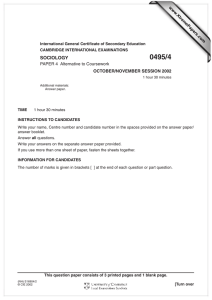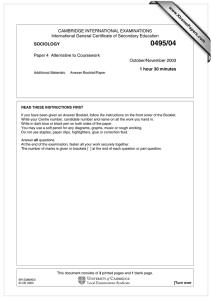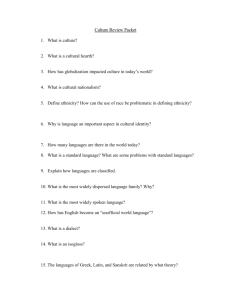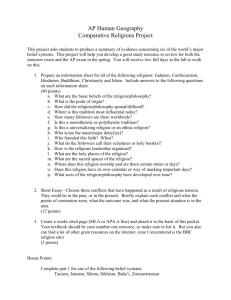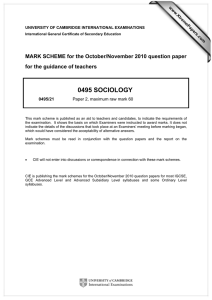www.XtremePapers.com
advertisement
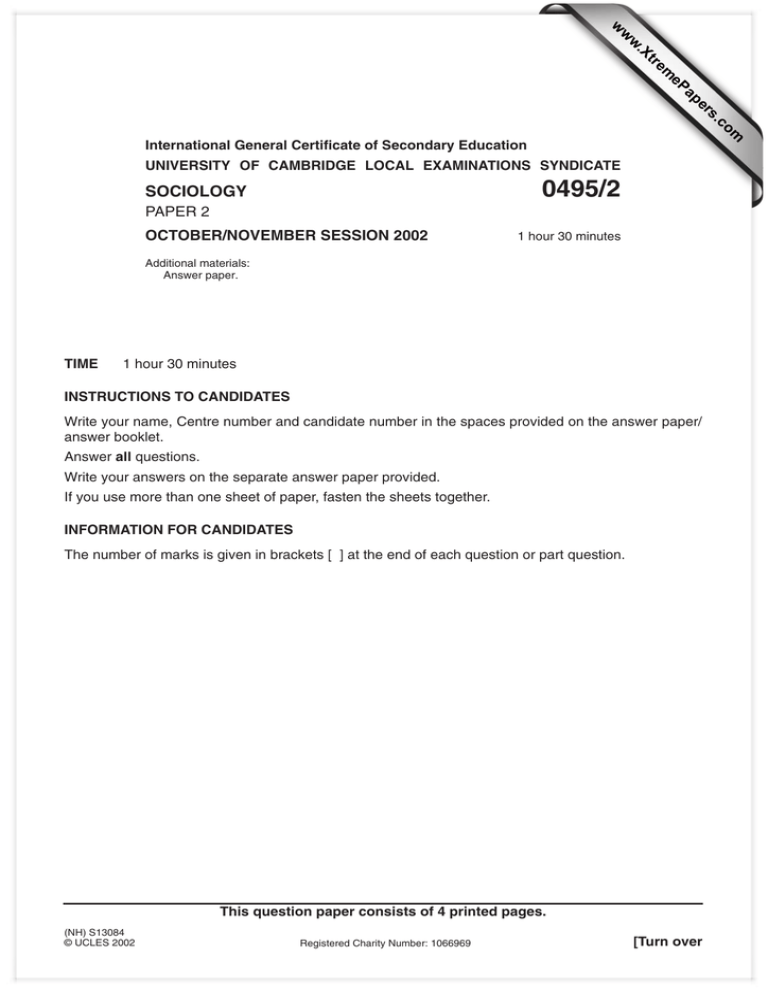
w w ap eP m e tr .X w om .c s er International General Certificate of Secondary Education UNIVERSITY OF CAMBRIDGE LOCAL EXAMINATIONS SYNDICATE 0495/2 SOCIOLOGY PAPER 2 OCTOBER/NOVEMBER SESSION 2002 1 hour 30 minutes Additional materials: Answer paper. TIME 1 hour 30 minutes INSTRUCTIONS TO CANDIDATES Write your name, Centre number and candidate number in the spaces provided on the answer paper/ answer booklet. Answer all questions. Write your answers on the separate answer paper provided. If you use more than one sheet of paper, fasten the sheets together. INFORMATION FOR CANDIDATES The number of marks is given in brackets [ ] at the end of each question or part question. This question paper consists of 4 printed pages. (NH) S13084 © UCLES 2002 Registered Charity Number: 1066969 [Turn over 2 CULTURE AND SOCIALISATION Religion Introduction In most societies there are people who have religious beliefs that influence their way of life. There are many different religions throughout the world, for example Christianity, Islam and Buddhism. The following sources present evidence about religion in various parts of the world. Study the sources carefully before answering the questions. Source A World religions The major world religions have many followers in different countries. The Size of World Religions in 2001 World religion Number of followers Christianity 1800 million Islam 1000 million Hinduism 720 million Buddhism 300 million Confucianism 6 million Sikhism 18 million Judaism 17 million Questions on Source A Study Source A carefully 1 (i) How many followers did Christianity have in 2001? [1] (ii) Which world religion had 300 million followers in 2001? [1] 0495/2 W02 3 Source B Studying religious groups I wanted to find out why people joined religious groups. To do this I decided to do a case study of a local religious group. The group had developed in the last few years in my country. It was a small sect with many young people who lived together. They gave up most of their private property and handed over their money to the group when they joined. Questions on Source B Study Source B carefully 2 In sociological research what is meant by a case study? [2] 3 Describe two advantages of case studies. [4] 4 Give three reasons why the evidence described in Source B may not be accurate or reliable. [6] Source C A diary extract from a member of a religious group in Canada After breakfast we gathered for morning worship and prayers. I read from The Bible and Peter talked. The Spirit of God was really with us so we went out and spoke to people in the Toronto streets. Several people came back to the community afterwards. They were interested in joining our group. Questions on Source C Study Source C carefully. 5 In sociological research, what is documentary evidence? 6 Identify one advantage and one disadvantage of documentary evidence in sociological research. [2] 7 How useful is Source C as evidence of the activities of all religious groups? 0495/2 W02 [2] [6] [Turn over 4 Source D Religious experience Over 1000 questionnaires were sent to members of the public. The sample was based upon the local register of electors i.e. those people who are listed as able to vote in local elections. The questions were about their religious experiences and the effect of faith upon their lifestyle. Over 80% of those who returned the questionnaire claimed to have had religious experiences, for example miracles and answers to prayer. Questions on Source D Study Source D carefully. 8 Give three possible causes of bias or inaccuracy in evidence collected by questionnaires. 9 ‘People join religious groups because of the influence of friends and family.’ Describe the methods sociologists might use to test this claim. 0495/2 W02 [3] [3]

